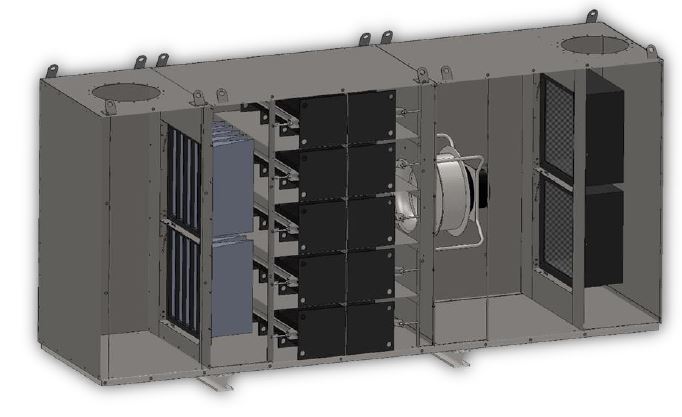Ventilation of corrosive gases
The air purification in an electrical clean room must be carried out with extreme precision. To achieve this, it is essential to understand the specific requirements of this application, starting with the calculation of heat loss in the operating rooms. This calculation takes into account parameters such as specific heat, the required amount of fresh air, and battery power to ensure continuous operation.
Two Methods
To treat smoke pollutants, two approaches are commonly employed. The first involves capturing the pollutant by accumulating it on a support, such as activated charcoal. This method traps harmful substances present in emissions.
The second approach entails chemical neutralization of the pollutant using a compound added to the support. In this case, chemical filtration modules in the form of granules are used. These granules contain chemical reagents capable of reacting with pollutants, transforming them into less harmful or innocuous compounds.
When smoke flow rates and pollutant concentrations are higher, it is necessary to opt for a more robust solution. This involves installing a dust removal system with the injection of an appropriate product, often lime.
What equipment?
A key element of this system is the filter housing, which must be designed to withstand the most demanding conditions. This housing is made of Inox 304 stainless steel sheets, ensuring durability and resistance to corrosion. The housing is placed on the existing frame and connected to the existing housing to ensure seamless integration.
The heart of this air purification system is an industrial EC fan, equipped with built-in variable speed control and a pressure probe, specially sized for the application at hand with an appropriate air flow rate. The backward-inclined blades of the fan provide exceptional performance.
One of the major advantages of this fan is that it is directly driven by the motor, eliminating the need for regular belt maintenance. The regulation of the air flow is provided by a pressure probe directly connected to the fan, ensuring a constant air flow under all operating conditions.
The connecting duct, also made from Inox 304 stainless steel, ensures a smooth transition between the housing and the existing ventilation network. This duct consists of sections of piping, branches, elbows, clamps, and support rods, and is designed to minimize pressure loss and optimize the distribution of purified air.
To effectively monitor and control the system,pressure switches are installed. A pressure switch of 0-300 Pa is used for the F7 filterto ensure precise monitoring of its condition. Another pressure switch of 0-500 Pa is dedicated to the operation of the fan, allowing for an immediate response to pressure variations in the system.
Disassembly and assembly
The entire installation is designed to follow the direction of airflow, ensuring maximum efficiency of air purification. Furthermore, the removal of the existing installation, including the reducer, fan, and duct up to the entrance of the room, is carried out carefully, and the waste is disposed of in a specific bin in accordance with regulations.
In conclusion, the installation by the Belgian engineers of Airwatec meets the strictest standards for safety and performance in air purification in critical environments. Thanks to high-quality components, careful design, and precise control, it ensures optimal protection against harmful and corrosive gases, providing a safe and healthy working environment for everyone in it.
